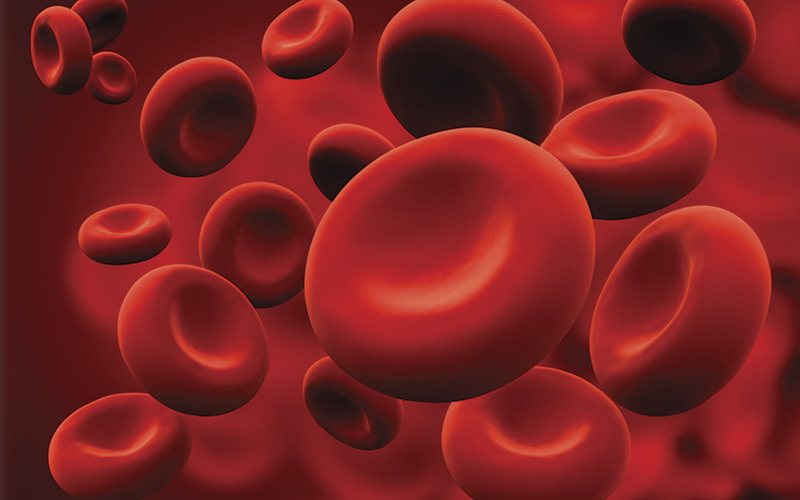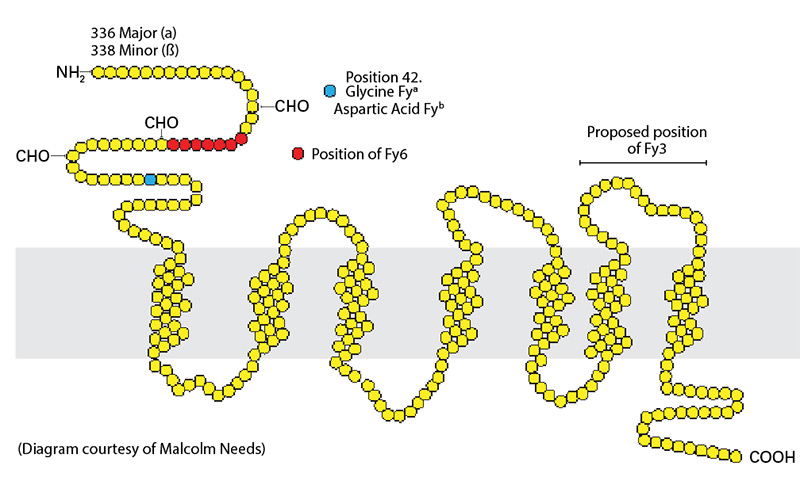Head of RCI Laboratory Martin Maley gives an introduction to the Duffy blood group system.

When it comes to learning more about an interesting blood group system (BGS), Duffy is probably perfect. Not too many antigens (5); well documented, clinically significant antibodies, disease association (malaria being the prime example) and, in the current climate of the proliferation of DNA testing, interesting genetic mutations (GATA-1) are always a bonus.
Duffy BGS antigens
The Duffy BGS has five main antigens recognised by the International Society of Blood Transfusion (ISBT): Fya was described in 1950 by Cutbush et al, Fyb in 1951 by Ikin et al, and Fy3 in 1971 by Albrey et al. Two further antigens (Fy5 and Fy6) exist within the system, but are rarely chanced upon. The prevalence of the antigens in Caucasian, Black and Chinese populations is detailed below.
There is also the further complication of Fymod (Fyx) antigen, which is a weakened form of the Fyb antigen – and which is, therefore, not detected by all available anti-Fyb reagents.

Duffy BGS antibodies
Anti-Fya was first described in the serum of a multi-transfused haemophiliac patient, a certain Mr John Duffy. The last two letters of his surname were taken to be used to denote the name of the antigen. Anti-Fya can cause mild to severe haemolytic transfusion reactions (HTR), and mild to severe (but only rarely) haemolytic disease of the fetus and newborn (HDFN). Anti-Fya , in particular, is classically found in combination with other antibodies, and these mixtures can make positive conclusive antibody identification difficult. This, in turn, can lead to issues in finding compatible blood, should transfusion be required.
Identification of the Fyb antigen followed in 1951, when it was shown to be antithetical to the Fya antigen. Although found much less commonly than its counterpart, anti-Fyb can also cause occasional severe HTR, but is usually only associated with mild HDFN.
Anti-Fy3 was described in 1971 in a previously transfused pregnant Australian woman. Because the antigen is resistant to enzyme treatment the urge to name it anti-Fyab was also resisted. This was fortunate, as it is now known that the Fy3 antigen is geographically remote from the position of the Fya /Fyb polymorphism.

Anti-Fy3
It has been known for years that people within the Black populations, with the Fy(a-b-) phenotype have been transfused with Fy(a+b-), Fy(a+b+) and/or Fy(a-b+) blood, and yet most do not produce anti-Fy3.
Many people within the Black populations are homozygous for a mutation within an erythroid-specific, GATA-1, transcription-factor binding site, upstream of the coding region of the Duffy gene.
This mutation prevents expression of the Duffy glycoprotein on red cells, but not on other cells.
Duffy glycoprotein was found to be expressed in endothelial cells lining post-capillary venules of soft tissues and splenic sinusoids.
Duffy mRNA was not detected in the bone marrow of such individuals, but was present in their lung, spleen and colon.
This coding sequence is usually identical to that of FYB, although amongst people from Papua New Guinea, the coding sequence is often identical to FYA.
The immune system of such individuals does not recognise the Fya and/or Fyb antigen as “foreign”, and they will not, therefore, produce anti-Fy3.
Disease association
There are numerous examples of Duffy system antigens being linked to disease states – the classical example being its involvement in susceptibility to certain strains of malaria.
There is a selective advantage in being Fy(a-b-) in areas where malaria is endemic. Miller et al found Fya and Fyb antigens act as receptors for malarial infestation of red blood cells and that Fy(a-b-) red cells are resistant to invasion by Plasmodium knowlesi and P. vivax.
Duffy antigen receptor for chemokines (DARC) has been found to be associated with a survival advantage in leukopenic HIV patients. The recessive African-specific DARC null allele increases the risk of HIV-1 infection approximately three-fold.
DARC has also been implicated in the regulation of the growth of prostate cancer tumours, and its interaction with CD82 due to its presence on vascular endothelial cells acts to inhibit the spread of cancer cells.
Martin Maley is Head of RCI Laboratory at NHS Blood and Transplant and a member of the IBMS Transfusion Advisory Panel. He would like to credit Geoff Daniels’ book Human Blood Groups, published by Blackwell Science, which influences this article.
Image Credit | iStock
References
1. Mollison PL, Parkin M. A new human blood group. Nature, Lond. 1950; 165: 188-189. doi: 10.1038/165188b0.
2. Ikin EW, Mourant AE, Pettenkofer HJ, Blumenthal G. Discovery of the expected haemagglutinin, Anti-Fyb. Nature 1951; 168: 1077-1078.
3. Chown B, Lewis M, Hiroko K. The Duffy blood group system in Caucasians: evidence for a new allele. Amer J hum Genet 1965; 17: 384-389.
4. Albrey JA, Vincent EER, Hutchinson J, Marsh WL, Allen FH, Gavin J, Sanger R. A new antibody, anti-Fy3, in the Duffy blood group system. Vox Sang 1971; 20: 29-35. doi: 10.1111/j.1423-0410.1971.tb01797.x.
5. Daniels G. Human Blood Groups. 2nd edition, 2002, Blackwell Science.
6. Miller LH, Mason SJ, Dvorak JA, McGinniss MH, Rothman IK. Red cell receptors for (Plasmodium knowlesi) malaria: Duffy blood group determinants. Science 1975; 189: 561-563. doi: 10.1111/j.1365-2141.1977.tb00656.x.
7. Reid ME, Lomas-Francis C, Olsson ML. The Blood Group Antigen FactsBook. 3rd edition, 2012, Elsevier Academic Press.
8. Weiss, R. Influence of Duffy antigen receptor for chemokines on HIV infection. Retrovirology 2013; 10 (suppl 1: O31) Biomed Central
